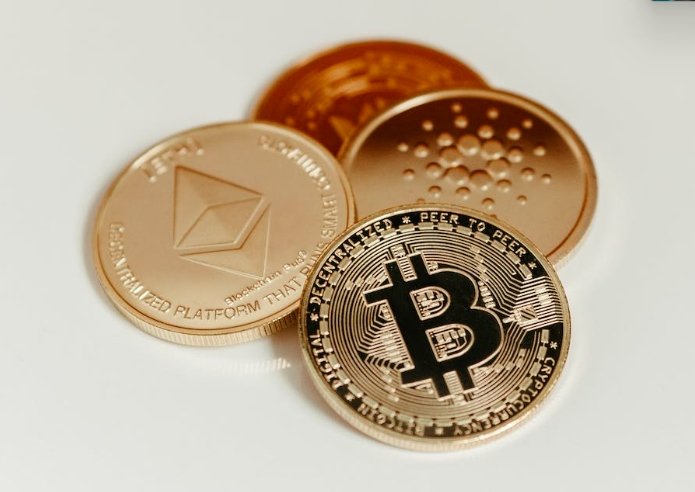The Future is Here: Understanding Decentralized Finance (DeFi) is an important topic of discussion in today’s world. As the world moves forward, the need for secure, decentralized financial solutions is ever increasing. DeFi (Decentralized Finance) is a new area of finance that is based on blockchain technology and is designed to operate without the need for a central authority. It allows for peer-to-peer transactions, secure lending and borrowing, and decentralized asset management.
DeFi is a revolutionary concept that has the potential to change the way we view and interact with money. It has the potential to democratize finance and provide access to financial services to those who are traditionally excluded from the traditional banking system. DeFi has already seen a rapid growth in recent years, with a number of projects being developed to make it easier for people to access and use DeFi products and services. DeFi is an important part of the future of finance and its potential is only beginning to be realized.
DeFi has its roots in the early days of cryptocurrency and blockchain technology. Over the years, the technology has been refined and developed to create the secure, decentralized financial solutions we see today. Through the use of smart contracts and decentralized applications, DeFi has made it possible to create financial products that are secure and transparent. DeFi has also opened up new opportunities for investors, allowing them to access a wider range of investments and services than ever before.

DeFi is an exciting and rapidly evolving field that has the potential to revolutionize the way we view and interact with money. By providing access to secure and transparent financial products and services, DeFi has the potential to make financial services accessible to everyone and bring about a financial revolution. It is an important topic of discussion and one that is sure to continue to evolve and grow in the years to come.
How DeFi works
DeFi, which stands for Decentralized Finance, is a revolutionary financial system that is built on blockchain technology and smart contracts. It enables the creation of decentralized applications (dApps) that are not controlled by any single entity. The DeFi ecosystem is composed of a wide range of protocols, such as Decentralized Exchanges (DEXs), Stablecoins, and Decentralized Lending and Borrowing platforms.
Blockchain Technology and Smart Contracts
Blockchain technology is a distributed digital ledger that is used to record and store data. It is a secure and immutable system that enables the transfer of digital assets without the need for a third-party intermediary. Smart contracts are self-executing pieces of code that can be used to automate the execution of transactions or agreements between two or more parties.
Decentralized Applications (DApps)
Decentralized applications (DApps) are applications that are built on blockchain technology and smart contracts. They are open source and decentralized, meaning that they are not controlled by any single entity. DApps are used to facilitate the transfer of digital assets on the blockchain, and can be used to create financial services, such as lending and borrowing.
DeFi Ecosystem and Protocols
The DeFi ecosystem is composed of a wide range of protocols. Decentralized Exchanges (DEXs) are used to exchange digital assets such as cryptocurrencies and tokens. Stablecoins are digital tokens that are designed to maintain a stable value, and are used to facilitate transactions on the blockchain. Decentralized Lending and Borrowing platforms are used to facilitate peer-to-peer (P2P) lending and borrowing of digital assets.
Benefits:
• Increased liquidity
• Reduced risk and volatility
• Increased transparency
• Lower transaction costs
• Increased access to financial services
Tips:
• Do your own research – Research the project and team before investing
• Diversify – Diversify your portfolio with different DeFi projects
• Stay informed – Stay up to date on the latest developments in the DeFi space
• Use caution – Be aware of the risks associated with investing in DeFi projects
DeFi use cases and benefits
Decentralized Lending and Borrowing: Decentralized lending and borrowing is an important use case of the DeFi ecosystem. It enables users to lend and borrow crypto assets without the need of intermediaries. It helps to create an efficient and transparent lending market, which enables participants to access a wide range of lending options. Moreover, DeFi protocols provide borrowers with flexible repayment plans and low-cost options for borrowing capital. This helps to reduce the cost of borrowing, making it more accessible for everyday users.
Stablecoins and Payments: Stablecoins are an important element of the DeFi ecosystem, as they enable users to transfer and store value without the risk of price volatility. They are also used to facilitate payments in the DeFi space, allowing users to securely and quickly send money across borders. Additionally, users can also use stablecoins to access financial services, such as loans and investment products, without the need for a traditional bank.
Decentralized Exchanges (DEXs): Decentralized exchanges (DEXs) are another key part of the DeFi ecosystem, as they provide users with a platform to trade crypto assets without the need for a centralized authority. This helps to reduce the risk of manipulation, as well as increase the efficiency of the trading process. Additionally, DEXs also provide users with access to a wide range of tokens and assets, which makes it easier for users to invest in new projects.
Liquidity Provision and Yield Farming: Liquidity provision and yield farming are two of the most popular use cases of DeFi protocols. Liquidity provision enables users to provide liquidity to the market by locking up their assets in a pool, in exchange for rewards. Yield farming is a similar process, however it involves users staking their assets in order to earn rewards. Both of these activities help to increase the liquidity of the DeFi market, allowing it to grow and develop.
Insurance and Risk Management: Insurance and risk management protocols are another important aspect of the DeFi ecosystem, as they help to reduce the risk associated with investing in DeFi projects. Insurance protocols enable users to insure their investments, protecting them from any losses due to hacks or other security breaches. Risk management protocols, on the other hand, help to manage the risk associated with investing in DeFi protocols, by providing users with detailed insights into the performance of their investments.
Decentralized Identity and Reputation: Decentralized identity and reputation protocols are an important part of the DeFi ecosystem, as they enable users to control their digital identity and maintain a good reputation. Decentralized identity protocols allow users to securely store and manage their personal data, ensuring that it is secure and private. Reputation protocols, on the other hand, enable users to build a trustworthy reputation, which helps to increase their credibility in the DeFi space.
Benefits of DeFi:
• Greater access to financial services: The use of DeFi protocols has opened up access to a range of financial services, such as loans and investments, to the wider public, without the need for a traditional bank.
• Increased transparency: DeFi protocols are designed to be transparent and trustless, which helps to reduce the risk of manipulation and ensure that participants are able to make informed decisions.
• Reduced costs: By eliminating intermediaries, DeFi protocols are able to reduce the cost of services, making them more accessible to everyday users.
• Increased liquidity: The use of DeFi protocols has increased the liquidity of the market, allowing users to more easily access the services they need.
• Faster transactions: By utilizing blockchain technology, DeFi protocols are able to facilitate fast, secure and low-cost transactions.
Tips for DeFi Users:
• Research before investing: It is important to thoroughly research any project before investing, in order to ensure that you are investing in a reputable and secure project.
• Understand the risks: DeFi protocols involve a high degree of risk, so it is important to understand the risks associated with your investments.
• Diversify: Diversifying your investments is a key component of risk management, as it helps to spread the risk across multiple projects.
• Keep an eye on the market: Monitoring the market is important, as it helps to ensure that you are aware of any changes that may affect your investments.
• Stay informed: It is important to stay up to date with the latest DeFi news and developments, as this will help to ensure that you are making informed investment decisions.
Risks and challenges of DeFi
Security Risks and Hacks: Decentralized finance (DeFi) is a relatively new technology and is constantly evolving, which means it is prone to security risks and hacks. As DeFi platforms operate on public blockchains, hackers can potentially gain access to user funds and confidential information. Smart contract bugs and vulnerabilities are also a major concern, as they can be exploited to gain access to funds stored in the contract. To mitigate these risks, users need to make sure that the DeFi platform they choose is secure and they should follow best practices when it comes to storing their funds.
Regulatory Uncertainty: DeFi is a global phenomenon and it is currently unregulated, which can create uncertainty for users. Different countries have different regulations, and even within a single jurisdiction, the rules can be unclear. It is important for users to research the regulations in their region and make sure that they are compliant with any applicable laws.
Smart Contract Bugs and Vulnerabilities: Smart contracts are the backbone of DeFi, and they are susceptible to bugs and vulnerabilities. A bug or vulnerability can be exploited to gain access to funds stored in the contract. Therefore, it is essential for users to make sure that the smart contracts they use are thoroughly tested and secure.
Market Volatility and Liquidity Risks: DeFi is still a relatively new technology and the markets for DeFi assets are highly volatile. This can create liquidity risk for users, as it may be difficult to exit a position without incurring significant losses. To mitigate this risk, users should make sure to diversify their investments and keep an eye on the markets.
Future of DeFi
Trends and Innovations
The DeFi space is constantly evolving with new trends and innovations being added on a regular basis. DeFi projects are increasingly utilizing blockchain technology to bring new financial products and services to the market. These products and services are designed to provide users with more autonomy and control over their own financial freedom. This includes the use of stablecoins, decentralized exchanges (DEXs), and automated market makers (AMMs). In addition, DeFi is also taking advantage of new technologies such as artificial intelligence (AI), machine learning (ML), and quantum computing to create more efficient and secure financial systems.
Mainstream Adoption and Integration
As DeFi projects become more mainstream, DeFi is becoming increasingly integrated into existing traditional financial systems. This is being done through the use of cross-chain bridges and interoperability protocols. These bridges and protocols enable DeFi protocols to interact with traditional financial institutions and services, such as banks and stock exchanges. This integration of traditional and DeFi services means that more users are able to access and take advantage of the benefits of DeFi.

Interoperability and Scaling Solutions
As DeFi becomes more widespread, scalability and interoperability issues need to be addressed. This is being done through the use of scaling solutions such as sidechains and layer-2 protocols. These solutions allow DeFi protocols to scale more efficiently and securely, as well as interact with other protocols and services. This interoperability allows users to access and interact with different services and protocols, creating a more diverse and efficient financial ecosystem.
Social and Environmental Impact
DeFi has the potential to have a significant positive impact on society and the environment. DeFi protocols are decentralized and open source, meaning that anyone can access and use them. This means that DeFi has the potential to reduce inequality in access to financial services, as well as reduce the cost of financial transactions. In addition, DeFi protocols are also more energy-efficient than traditional financial systems, as they use fewer resources and generate less waste. This makes them a more sustainable and environmentally friendly solution.
Conclusion
The future of finance is here, and it is decentralized. Decentralized finance, or DeFi, is a new financial model created on the blockchain. It has the potential to revolutionize the traditional financial system with its trustless, transparent, and open-source nature. By allowing individuals to access financial services without the need for a middleman, DeFi can create a more equitable financial system.
The applications of DeFi are wide and varied, from tokenized assets and decentralized exchanges to yield farming and staking. By utilizing the power of smart contracts, DeFi protocols are able to create automated financial services that are secure and permissionless. This allows users to easily interact with the financial markets without the need for a bank or other financial institution.
DeFi has already started to transform the financial industry, but there is still much more to be done. New protocols and applications are constantly being created, and the potential of DeFi is only beginning to be explored. As more people come to understand the benefits of DeFi, we can expect to see more applications created and more people using DeFi to interact with the financial system.
The future of finance is here, and it is decentralized. Decentralized finance is creating a new financial system that is open, transparent, and secure. By allowing users to access financial services without the need for a middleman, DeFi is creating a more equitable financial system. As the potential of DeFi continues to be explored, the possibilities for the future of finance are endless. The future is here, and it is decentralized.
FAQs
1. What is Decentralized Finance (DeFi)?
Decentralized Finance (DeFi) is a new ecosystem of financial applications and services built on blockchain technology. DeFi offers users a secure and transparent way to access decentralized financial services such as borrowing, lending, exchange, and insurance.
2. How does DeFi work?
DeFi is powered by blockchain technology and smart contracts. These smart contracts allow users to access financial services without the need for a middleman or centralized authority. By removing the need for traditional financial institutions, DeFi makes it easier for users to access financial services with transparency and trust.
3. What are the benefits of DeFi?
DeFi offers a number of benefits to users including improved access to financial services, greater security, transparency, and trust, lower fees, and quicker transactions. DeFi also has potential to revolutionize the traditional banking system by providing users with more control over their finances.
4. What are the risks of using DeFi?
DeFi is still a relatively new technology and there are inherent risks associated with using DeFi services. These risks include the potential for smart contract vulnerabilities, lack of regulatory oversight, and price volatility. It is important for users to understand these risks before using DeFi services.
5. What is the difference between centralized and decentralized finance (DeFi)?
Centralized finance (CeFi) is a traditional banking system where all financial transactions are processed by a centralized authority such as a bank. Decentralized finance (DeFi) is powered by blockchain technology and smart contracts, allowing users to access financial services without the need for a middleman or centralized authority.
6. What are the most popular DeFi applications?
The most popular DeFi applications include decentralized exchanges (DEXs), lending protocols, stablecoins, and decentralized insurance.
7. What is a decentralized exchange (DEX)?
A decentralized exchange (DEX) is a type of cryptocurrency exchange that does not rely on a central authority. DEXs allow users to trade cryptocurrencies directly with each other in a secure and trustless environment.
8. What is a lending protocol?
A lending protocol is a type of DeFi application that allows users to borrow and lend cryptocurrency. Lending protocols can offer more competitive interest rates than traditional banking services, allowing users to maximize their returns.
9. What is a stablecoin?
A stablecoin is a type of cryptocurrency that is pegged to a stable asset such as the US Dollar or gold. Stablecoins provide users with a way to protect their funds from the volatility of the crypto markets.
10. What is decentralized insurance?
Decentralized insurance is a type of DeFi application that allows users to purchase insurance policies on the blockchain. Decentralized insurance can provide users with more flexibility and control over their insurance policies.


















